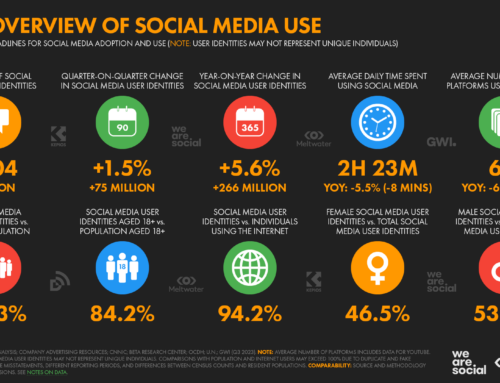
When I first drafted this blog article, it was intended to share why one of the nonprofits I work with had all intentions of staying on the controversial platform, Twitter, despite something of a platform exodus – because it met their needs. I was hoping to use the scenario to emphasize the importance of following marketing strategies that make the most sense for your nonprofit and the people you serve, regardless of what others are doing.
However, when the new CEO of Twitter engaged in some serious misbehavior online, we had no choice but to change our mind. In solidarity with the population we serve – that he had just offended – we had to question our presence on the platform. Our integrity, values, and commitment to the people we serve come first, and we believe that the same should be the case for all nonprofit marketers.
The moral of the story is that we believe you should pick your social media platforms and marketing strategies based on what works best for your nonprofit and the people you serve and not just what everyone else is doing – BUT it must also align with your values and beliefs.
To Tweet or Not to Tweet?
In October 2022, Elon Musk acquired Twitter, and since then, a number of changes have been implemented that have caused many users to seek out alternative social media platforms. The reinstatement of previously blocked accounts and introduction of controversial new policies sparked criticism and made some users uneasy about their experience going forward.
This sentiment was shared by many brands including some nonprofit organizations.
Twitter also recently laid off approximately 1,000 employees as part of a larger restructuring effort that left many Twitter users feeling uncertain about the future of the platform, its functionality, and its ability to continue to innovate and deliver value to its users. Not to mention, Musk was also recently caught making offensive comments to a former employee living with a disability – on his very own platform.
As a result of these changes and behaviors, both individual users and organizations have opted to shift their focus to other social media platforms that better align with their values and priorities. While Twitter remains a popular platform for many users, the recent changes have highlighted the importance of accountability in social media and the need for users to carefully consider the platforms they choose to engage with.
Although Twitter continues to boast great user engagement stats (around 40% according to eMarketer), it is the only social media platform whose user growth declined in 2022.
The Elusive Blue Checkmark
Despite the negative changes, Twitter has been rolling out several new features as of early 2023, including adding long-form notes, amplifying a Clubhouse-like audio community referred to as “spaces,” developing a new subscription-based model to provide users with access to exclusive content and features, integrating e-commerce into its platform to allow users to purchase products directly from tweets, and investing in new technologies such as machine learning and artificial intelligence.
They have also made some changes to their famous blue checkmark verification process. Twitter’s blue verification badge, which was originally meant to authenticate a user’s identity and voice, has undergone some significant changes. While Twitter’s verification process was initially open to anyone who could prove their identity and noteworthiness, under Musk’s leadership you must now be a participant in Twitter Blue, the company’s paid subscription service. They also recently announced that they are removing verification from users who were verified through their legacy verification program so that only Twitter Blue accounts will be verified going forward.
Whether or not it’s worth it to pay for Twitter Blue or to be verified on the platform is a hot topic of debate – especially for nonprofits. And to add to the decision process, other social media platforms are entering the mix with their own subscriptions services with exclusive features for individuals and businesses. Meta announcement their own subscription service, Meta Verified, which offers a verified badge on Instagram. Ultimately, the decision to pay for that coveted blue check mark on any platform is up to you and your marketing objectives.
Should I Stay or Should I Go Now?
Considering both the good and the bad, a number of nonprofit organizations still have no plans to leave Twitter …for now. This is because despite the platform’s changing features and leadership, many of their most important stakeholders remain as active users.
It’s important to remember that the purpose of social media outlets is to engage with your audiences, foster community, provide customer service, and achieve marketing/business goals. All of these things must be considered when evaluating whether or not a departure from the platform is necessary or recommended for your organization.
If your organization has reasons to prioritize communication and engagement with stakeholders who fall into categories like government officials and policy makers, current and prospective board members, and potential private funding partners including large and small corporate brands, etc., then Twitter may still be a good option. Additionally, many media and entertainment players also remain on the platform. That means if you’re looking for breaking news, some tweet play with the occasional A-B-C list influencer, or another way to engage with reporters, Twitter could still be worth considering… maybe.
The Struggle is Real: Making the Executive Decision
One key question to consider when deciding whether to stay or go on a platform like Twitter is, “if it wasn’t free, would we pay for this?”. This question alone, which encourages the evaluation of ROI, can help you not only prioritize which platforms are most meaningful to you, but also if it’s worth being there at all.
Here are some additional questions to ask yourself. These questions will help assess if your org’s presence continues to make sense as the landscape changes:
-
- Can this platform really help me achieve my marketing objectives (whether that’s to drive donations or sales, generate leads, or deepen relationships)?
- Has the platform been consistent in helping me meet those goals?
- Are my customers, donors, and other stakeholders here?
- Does this platform and my presence here add a positive reflection of my brand? Our values?
- As the platform landscape changes, is their updated technology or approach still viable or desirable for me, my followers, or stakeholders?
You really must ask yourself whether or not the platform and your content on it is resonating with your audiences. Is your audience engaging and responding to you on that platform? And are they converting to meet your nonprofit marketing goals!
Keep It or Kick It?
It’s essential to assess the value and return on investment of your social media presence, and not just stick with a platform because it’s popular or everyone else is using it. By evaluating what works best for your nonprofit organization and the people you serve, you can make informed decisions about which social media platforms to use and which to let go of. Additionally, if we learn only one thing from Elon, let it be that it is crucial to prioritize organizational values and morals when deciding on marketing strategies and platforms.
Keep in mind that social media platforms are constantly changing, and what works for your organization today may not be the best fit tomorrow. Regularly assessing your social media presence and stop going where or doing what no longer works for you on social and keep doing what does. Just remember, that’s going to be different for everybody.
Figure out what it is for you.
We invite you to go deeper on this topic by reviewing our recent webinar recording from April 13, 2023 Picking the Right Social Platforms for Your Nonprofit Moving Forward. You can get the recording (and attend all of our live webinars for 365 days) with an All-Access Pass.






